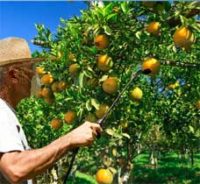Carbendazim Residues in Orange Juice

On December 28, 2011, the U.S. Food and Drug Administration (FDA) learned from a juice manufacturer that it had detected low levels of carbendazim (Derosal®) in some of its orange juice products and also in some of its competitors’ products. The pesticide was also reported in some Brazilian orange juice concentrate that had not been processed into finished product.[1]
Shortly thereafter, FDA sent a letter to the Juice Products Association—the trade association that represents the fruit and juice products industry—stating that carbendazim is a pesticide that is not approved for use on oranges in the United States and that its residues are not allowed in orange juice. Accordingly, FDA will not permit orange juice products containing measurable levels of carbendazim to continue to enter the country.
While FDA maintains that orange juice in the U.S. does not pose a safety concern due to the presence of this pesticide, the fact that carbendazim and its residues have been detected in imported orange juice is nonetheless illegal.
Carbendazim is a fungicidal pesticide that is not legal for use on oranges in the U.S. but is allowed in many countries. The burden of proof falls on juice importers to ensure that such products are not contaminated prior to entry into U.S. markets.
Food Safety Magazine Editorial Board member Larry Keener states that importers have a responsibility to follow the code of regulations for any agricultural product they are bringing into the U.S. from a foreign country, including asking the foreign supplier what chemicals are put on the product; what residues remain after harvest and processing; what the risks to public health may be and to establish programs in that country for quality testing and screening of those products. Only after the test results are known can one agree to take receipt of the food product.
Keener emphasizes that contracts should be used to establish best practices, including all processes, monitoring programs and banned chemicals, and to give suppliers options should a particular chemical used in that country not be acceptable for use in the U.S. An objective third-party testing laboratory (properly qualified) can confirm that the contract is being implemented.
Problems occur, he notes, when the supply chain cannot be verified. Importers must be exceedingly aggressive in this regard.
Keener provides the following example. When importing food from the Middle East, quality reports turned up lindane, an agricultural, neurotoxic insecticide. He immediately hopped a plane to the region to visit the producer. Upon entering the plant, he smelled a chemical with a characteristic pesticide odor, which had been used to control a recent insect infestation at the facility. The chemical was lindane and it had inadvertently contaminated the food.
Coordination is imperative between importers and exporters, as well as with any brokers who may find a grower or processor for the importer. Having additional layers between the importer and primary producer can sometimes obscure supply chain verification; therefore, a thorough knowledge of all involved parties is essential.
It is also of critical importance that a food safety focus be maintained. If shipping specifications are left to logistics people instead of those responsible for food safety, for instance, one risks inviting trouble. As another example, Keener notes that a logistics individual decided to use cheaper pallets, found to be inferior, to store products during the trans-Mediterranean and trans-Atlantic crossing as a cost-cutting measure, which caused damage to the products and rejection at the port of entry.
Returning again to the specifics of carbendazim in imported orange juice, FDA has determined that “...no action is needed to remove product from the market and that the orange juice consumed by the public does not pose safety concerns due to the low levels of carbendazim residues found in FDA testing. At this time, the agency does not believe there is a need to continue testing for carbendazim in orange juice products already in the United States; however, we do plan to conduct follow-up testing...,”[2] possibly as a result of some external pressure, perhaps from consumers and food safety advocates. The U.S. Environmental Protection Agency has determined that any level of carbendazim in orange juice below 80 ppb does not pose a health risk,[3] although carbendazim-contaminated samples of orange juice and orange juice concentrate (containing 10 ppb or more carbendazim) have been found from Canada and Brazil, presumably not a risk to public health by these standards.
Companies that find themselves in the midst of a food safety event, whether an outright recall or the subject of further investigation and testing (such as that resulting from the carbendazim contamination of orange juice), if they are to survive, must take a different approach to food safety afterwards.
Food safety is not achieved by accidental or superficial means. Achieving it requires exquisite planning and expert knowledge. The entirety of the supply chain must be investigated. Vagaries and ambiguities require clarification. All identified risks and their causal relationships demand solutions. Agricultural chemicals in the food supply, safe and otherwise, must be scrutinized. Avoiding the improper use or crop application of a pesticide is the best means for averting regulatory action or producing food that is questionable in terms of its public health status. In this particular episode and despite the best efforts of FDA to provide assurances that the residue-tainted orange juice is safe, the negative impact of this report on markets and consumers remains. This regulatory scare, in other words, has the same chilling impact as a true food safety scare on markets and consumers. Science-based harmonization of food safety standards, especially those related to food additives, processing aids and agricultural chemicals, would have avoided this incident altogether.
Barbara VanRenterghem, Ph.D., is the editorial director of Food Safety Magazine. She can be reached at barbara@food-safety.com.
Looking for a reprint of this article?
From high-res PDFs to custom plaques, order your copy today!







